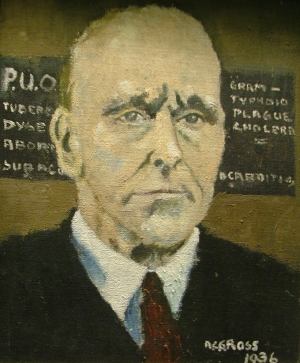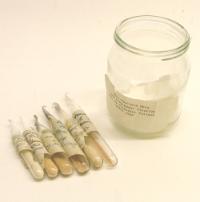Allergy and Immunity - Early Contributions in Dundee

Prof Tulloch, from a painting by ACG Ross, 1936
(Tayside Medical History Museum)
Professor William Tulloch (1887-1966)
A native of Dundee and appointed to the Chair of Bacteriology in the Medical School 'ad vitam aut culpat' (for life or until fault), Tulloch stayed in this post for 42 years before retiring voluntarily aged 74. His unique teaching and examining relationship with the students helped to produce enthusiastic recruits for his speciality.

The problems confronting the Royal Army Medical Corps during World War I related to wound infection (notably tetanus) and outbreaks of cerebrospinal meningitis which occurred in crowded barracks. Tulloch did important work in both, for which he was awarded the Military OBE. His studies on tetanus undoubtedly influenced the methods adopted in the handling of the wounded, and in meningitis showed that isolation of meningococcal carriers was not a practical possibility - though it took the army another 20 years to stop examining contacts of cases for nasopharyngeal meningococci.
Image above: Samples used by Prof Tulloch in complement fixation and vaccinia studies, 1940s (Tayside Medical History Museum, DUNUC 4037)
Professor Dan Cappell (1900-1976)
A Glaswegian by birth, Cappell occupied the Chair of Pathology at the Medical School from 1931-45 before returning to his home city. Following the events at Munich in September 1938 and reports from the Spanish Civil War, Cappell had the foresight to set up the Dundee Blood Transfusion Service, which was ahead of any action by the Department of Health and the model for all the regional services that were hastily formed on the outbreak of hostilities.
In 1901 the Austrian Karl Landsteiner discovered the existence of blood groups, and seven years after receiving the Nobel Prize he went on to identify the Rhesus (Rh) factor in 1937. In the process of setting up the blood transfusion service in Dundee, Cappell gathered a unique collection of data on the complexities of the newly discovered Rhesus system, and became pre-eminent in the elucidation of the Rh antigens and their inter-relationships.
Cappell's contribution in this field never received the recognition that he deserved, partly because he counted the spread of practical information more important than his scientific reputation, and indeed he probably played the major part in informing the medical and nursing professions.

Prof Cappell
(University of Dundee Archive Services)

Dr Riley
(Tayside Medical History Museum)
Dr James Riley (1912-1985)
A native of Settle in Yorkshire, Jim Riley was a surgeon during the war but had to retrain in radiotherapy when he contracted a skin condition of his hands. He was consultant at Dundee Royal Infirmary until 1974.
Dr Riley had always been fascinated by research and was an avid reader of the great heroes of the past such as Paul Ehrlich. He is said to have owned one of the great man's famous instruction blocks, which were notoriously difficult to decipher. While still a medical student Ehrlich was the first to describe the mast cell in humans, although left it to others to solve the riddle of what it does.

Jim Riley set out to solve this riddle, and made a good start with a notable series of experiments conducted during the 1950s in a corner of his room at DRI. His landmark paper, written with the pharmacologist Geoffrey West, was published in the Journal of Physiology in 1952. Their establishment of the mast cell granule as the major source of histamine was a fundamental contribution to the understanding of inflammatory and allergic reactions. Riley's research made him an internationally respected authority, and led to a Claude Bernard Visiting Professorship in Montreal and election as a Fellow of the Royal Society of Edinburgh.
Image above: Original equipment used by Dr Riley in his histamine experiments at Dundee Royal Infirmary in the 1950s (Tayside Medical History Museum, DUNUC 8630-8662)